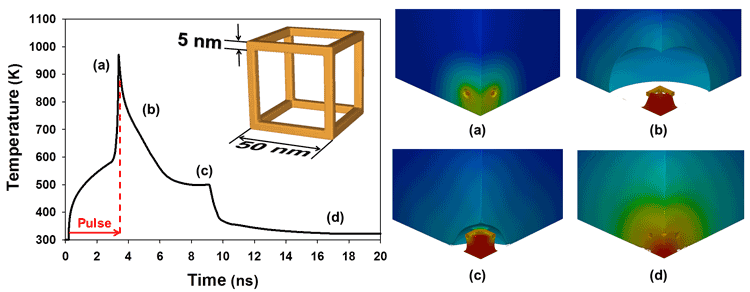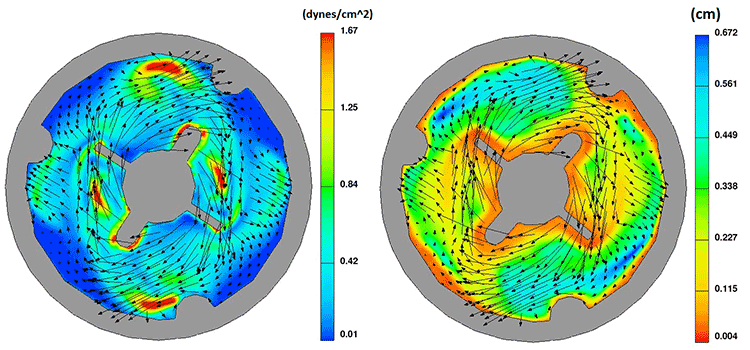This article was contributed by Prof. Edward Furlani and his students from the University at Buffalo, SUNY.
Microfluidics and nanofluidics are interdisciplinary fields that involve the science and technology of fluid flow through materials and systems with micro to nanoscale features. Research and applications in these fields have proliferated in recent years due to unique advantages of small-scale fluidic processes combined with rapid advances in materials development and system integration. Microfluidic and nanofluidic systems enable highly efficient, repeatable and rapid processing of small fluid samples for applications that can involve integrated sequential or multiplexed processes such as chemical reactions, fluid heating, mixing, and sensing. Research in Professor Furlani’s group involves modeling and simulation towards the development of novel processes and devices. Much of this work emphasizes the use of state-of-the-art computational fluid dynamics (CFD) analysis for studying fluidic phenomena involving Newtonian and non-Newtonian fluids, conjugate heat transfer, phase change analysis, free-surface and multiphase analysis, fluid media interactions, flow through porous media, fully coupled fluid-structure and particle-fluid interactions and colloids. Three papers will be presented at the International Nanotech Conf. 2014 that will take place June 15-18, at the Gaylord National Hotel and Convention Center in Washington, D.C. They showcase some of the breakthrough work being done at the University at Buffalo. Here we present a preview of these works and some of the simulation results that were generated with FLOW-3D.
Analysis of Stem Cell Culture Performance in a Microcarrier Bioreactor System
Koushik Ponnuru1, Jincheng Wu1, Preeti Ashok1, Emmanuel S. Tzanakakis1,3,4,5,6 and Edward P. Furlani1,2
1Dept. of Chemical and Biological Engineering, 2 Dept. of Electrical Engineering, 3Dept. of Biomedical Engineering, 4New York State Center of Excellence in Bioinformatics and Life Sciences, 5Western New York Stem Cell Culture and Analysis Center, 6Genetics, Genomics and Bioinformatics, University at Buffalo, SUNY
An analysis of the effects of the turbulent shear stress on cell culture in a stirred tank microcarrier bioreactor system using a synergistic combination of CFD-based simulations and experiments is presented. A 3D computational model of Corning’s bench-scale spinner flask was built using a state-of-the-art CFD software, FLOW-3D. The effects of parameters such as the impeller speed, culture medium fluid properties, and particle size on the steady-state shear stress acting on the cell-laden microcarrier particles in the bioreactor are studied using CFD analysis. This is used to predict the precise shear conditions experienced by cells and identify optimum operating conditions that prevent turbulent shear damage of the cells. In addition, the effect of the shear of the pluripotency of hPSCs is studied by determing the percentage of cells carrying the pluripotency markers Oct4, Sox2, and Nanog using flow cytometry and quantitative PCR.
Numerical Analysis of Fully-Coupled Particle-Fluid Transport and Free-Flow Magnetophoretic Sorting in Microfluidic Systems
Chenxu Liu1, Xiaozheng Xue1 and Edward P. Furlani 1,2
1Dept. of Chemical and Biological Engineering, 2Dept. of Electrical Engineering, University at Buffalo, SUNY
Magnetic particles are increasingly used in microfluidic systems to selectively separate and sort biomaterial for biomedical and clinical diagnostic applications. A computational model is introduced that can be used for the rational design of such systems. The model takes into account dominant mechanisms that govern particle transport including magnetic and hydrodynamic forces, fully-coupled particle-fluid interactions, and magnetic dipole-dipole interactions that induce self-assembly of the particles. It is demonstrated via application to a continuous flow separation system and a microfluidic mixing process based on rotating self-assembled particle chains.
Numerical Analysis of Laser Induced Photothermal Effects using Colloidal Plasmonic Nanostructures
Ioannis H. Karampelas1, Young Hwa Kim2 and Edward P. Furlani 1,2
1Dept. of Chemical and Biological Engineering, 2 Dept. of Electrical Engineering, University at Buffalo, SUNY

Colloidal noble metal (plasmonic) nanostructures are finding increasing use in a variety of photothermal applications that range from nanoparticle synthesis to bioimaging to medical therapy. In many applications, a pulsed laser is used to excite the nanostructures at their plasmon resonance frequency, which results in a peak absorption of incident photons and highly localized (sub-wavelength) field enhancement. In addition to enabling efficient nanoscale heating from a remote source, the resonant heating wavelength can be tuned within the ultraviolet through near-infrared spectrum by adjusting the geometry of the nanoparticle during synthesis. Our group has developed computational models that predict fundamental photonic and thermo-fluidic behavior of nanosecond-pulsed, laser-heated colloidal metallic nanoparticles. These models have been used to simulate energy conversion within nanoparticles at plasmon resonance, heat transfer from a particle to the surrounding fluid and phase change of the fluid leading to homogenous bubble nucleation. Various nanoparticle geometries have been studied including nanorods, nanotori, nanorings and nanocages. The analysis shows that process parameters such as the laser intensity, incident wavelength, polarization, pulse duration and the orientation and shape of the nanoparticles can be tuned to optimize the photothermal process. Plasmonic nanoparticles are currently used in photothermal applications involving bioimaging, drug delivery and the therapy of malignant tissues.


